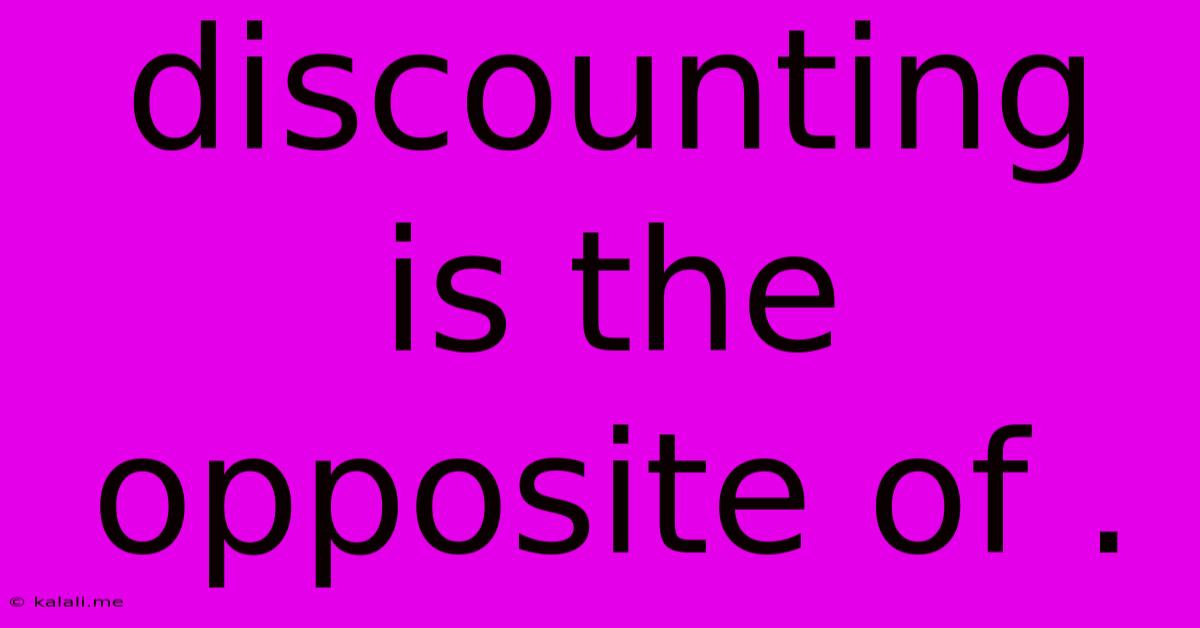Discounting Is The Opposite Of .
Kalali
Jun 14, 2025 · 3 min read

Table of Contents
Discounting is the Opposite of: Value Creation and Premium Pricing Strategies
Discounting, the practice of reducing the price of a product or service, is a common tactic in business. But what's the opposite? It's not simply charging a higher price. The true opposite of discounting lies in a holistic approach that prioritizes value creation and premium pricing strategies. This article delves into the core differences and explores why focusing on value often yields more sustainable success than relying solely on price reductions.
Understanding the Drawbacks of Over-Reliance on Discounting
While discounting can boost short-term sales, it carries several significant drawbacks:
- Erosion of Brand Perception: Constant discounting can devalue your brand in the eyes of consumers. Customers may start to expect discounts and refuse to pay full price, leading to decreased profitability.
- Price Wars: Discounting can trigger price wars with competitors, squeezing profit margins for everyone involved. This can be especially damaging in industries with low barriers to entry.
- Customer Loyalty Issues: Customers attracted solely by discounts are less likely to be loyal. They'll switch brands as soon as they find a better deal elsewhere.
- Negative Impact on Profitability: While sales volume might increase temporarily, the reduced price per unit can significantly impact overall profitability, potentially leading to financial losses.
The Opposite: Building Value and Implementing Premium Pricing
The true opposite of discounting isn't just charging more; it's about building a strong value proposition and justifying a higher price point. This involves:
- Superior Product/Service Quality: Offering a product or service that's demonstrably superior in terms of quality, features, performance, or durability. Think of the difference between a generic brand and a premium, luxury item.
- Exceptional Customer Experience: Providing outstanding customer service, personalized support, and building strong relationships with your clients. Excellent customer service fosters loyalty and justifies a higher price.
- Strong Branding and Positioning: Developing a strong brand identity that resonates with your target audience. This creates an emotional connection and willingness to pay a premium for the perceived value.
- Unique Selling Proposition (USP): Offering something truly unique and different that competitors cannot easily replicate. This allows you to command a higher price based on exclusivity and innovation.
- Strategic Pricing Models: Implementing pricing strategies that align with your value proposition. This might include value-based pricing, premium pricing, or even subscription models.
Examples of Value-Based and Premium Pricing in Action
Consider luxury brands like Rolex or high-end fashion houses. They rarely offer discounts because their products are associated with exclusivity, quality, and craftsmanship. Their pricing reflects the perceived value they offer, attracting customers who are willing to pay a premium for these attributes.
Similarly, software-as-a-service (SaaS) companies often utilize subscription models, providing ongoing value and justifying their recurring pricing.
Conclusion: A Long-Term Perspective
While discounting can be a useful tool in specific circumstances, it shouldn't be the cornerstone of your pricing strategy. Building a strong value proposition, providing exceptional service, and implementing premium pricing strategies are far more sustainable approaches to long-term success. Focus on creating value, and the price will follow. This is the true opposite of relying solely on discounting as a sales driver. By investing in quality, building a strong brand, and providing exceptional customer experiences, businesses can command premium prices and foster customer loyalty – creating a more resilient and profitable business model.
Latest Posts
Latest Posts
-
Which Of The Following Describes A System
Jun 14, 2025
-
Strategic Human Resource Management Exam Questions And Answers
Jun 14, 2025
-
What Is The Least Common Factor Of 36 And 45
Jun 14, 2025
-
What Is The Prime Factorization For 58
Jun 14, 2025
-
University Of Washington Average Sat Score
Jun 14, 2025
Related Post
Thank you for visiting our website which covers about Discounting Is The Opposite Of . . We hope the information provided has been useful to you. Feel free to contact us if you have any questions or need further assistance. See you next time and don't miss to bookmark.